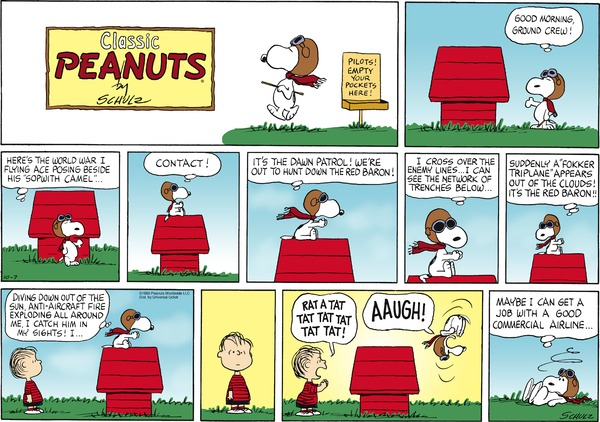22 August 2018
Manfred von Richthofen is the most famous aviator of World War I, if not of all time. Credited with eighty air-to-air victories, he shot down more planes than any other flyer in the war. And he is popularly known as the Red Baron, probably because as commander of Jagdgeschwader (fighter wing) 1, known as the Flying Circus, he flew in a bright-red Fokker triplane. But researcher Brett Holman has discovered something quite interesting about the nickname Red Baron: until the mid-1960s, almost sixty years after his death in 1918, Richthofen was rarely called the Red Baron. Instead, the popularity of that nickname derives from the Peanuts comic strip, which often featured the beagle Snoopy engaging in imaginary dog fights with the German nemesis.
The nickname Red Baron did exist during the war, but was apparently quite rare. There is only one known mention of it in published sources from the war years. This is from the newspaper Graphic, 25 May 1918:
Cavalry Captain Baron von Richthofen was shot down in aerial combat on the day when the German papers announced his 79th and 80th victories. Boyd Cable writes: “The Red Baron, with his famous ‘circus,’ discovered two of our artillery observing machines.”
Mentions of the nickname can be found after the war, but they are few and far between. There is this from the Washington Post, 30 September 1928:
The British ship flew right into the formation without firing a shot. Then the Red Baron himself dived down on it to find out what it was all about.
But then on Sunday, 10 October 1965, the comic strip Peanuts, by Charles Schulz, ran this strip:
References to Richthofen as the Red Baron began to become more and more common after this date. The novelty song “Snoopy vs. the Red Baron,” written by Phil Gernhard and Dick Holler, was released by the Royal Guardsmen in November 1966, which further contributed to the nickname’s popularity.
Here is an example from Time magazine of 24 March 1967 that shows how the term had become somewhat genericized by that date:
Students in Paris and London have been ransacking secondhand stores for old uniforms dating back to the Crimean and FrancoPrussian [sic] wars. But in the U.S., uniforms are generally out in favor of the Frank Nitti gangster look, including palm tree-studded ties and double-breasted pinstripe jackets. At Dartmouth, the particular “ drinking uni “ (for uniform) at the moment is the “ blow-lunch look “ (so called, one student explains, because “ when you look at one of those ties you want to blow your lunch “) topped off with a Red Baron Flying Ace helmet, complete with ear flaps and shrapnel holes.
Red Baron is a good example of why one should be careful in ascribing a date to a word or phrase without actual evidence of its use. The occurrence of an event, the coining of that event’s name, and when that name enters into the general parlance are not always the same.
Sources:
Ames, John. “The Stolen Air Mail.” Washington Post, 30 September 1928, SM9.
“The Follies that Come With Spring.” Time, 24 March 1967.
Holman, Brett. “When Was The Red Baron?” Airminded, 20 August 2018.


